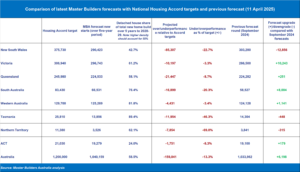- No products in the cart.


Master Builders Australia’s latest industry forecasts paint a cautiously optimistic picture for the building and construction sector, with signs of recovery emerging across the housing market.
However, the nation remains 160,000 homes short of the National Housing Accord target, underscoring the need for governments to take urgent, coordinated action to unlock the industry’s full potential.
Covering the full five-year Accord period, the forecasts show around 1.04 million new homes are likely to commence construction, short of the 1.2 million homes needed to ease Australia’s housing crisis.
Master Builders Australia CEO Denita Wawn said: “While the latest data gives us cause for cautious optimism, now is not the time for complacency.
“The housing market is beginning to show signs of life after a difficult two years, and with inflation and interest rates easing, the conditions are right to support greater investment in new housing. But we need all levels of government to step up.”
Master Builders says both major parties have acknowledged the need to address the housing crisis, but current efforts are still too piecemeal.
“We’re still tinkering at the edges. It’s time to take the foot off the brake and put in place the reforms and investment needed to properly unlock supply,” Ms Wawn said.
The Albanese Government’s focus on planning reform is a positive step, and Master Builders supports continued momentum through the National Planning Reform Blueprint. But this must be matched with commitments to improve access to home ownership and boost affordable and social housing options.
“We welcome both parties’ support for first home buyers, but we remain concerned by the lack of a clear Coalition plan for affordable and social housing.
“At the same time, Labor must do more to address the real costs of employing and training apprentices—particularly for the small businesses that make up 98 per cent of our industry,” Ms Wawn said.
The Coalition’s proposed wage subsidy and apprentice payment measures are a sensible response to skills shortages and rising employment costs.
“These are targeted policies that recognise the pressure small and medium businesses are under. Labor should match this level of support,” Ms Wawn added.
Industrial relations reform remains a major concern, with Master Builders reiterating its warning over damaging changes implemented during this term of government.
“The IR changes, and the unchecked behaviour of the CFMEU, are the elephant in the room.
“While Labor’s appointment of an administrator is a step forward, it falls short of the structural change required. The Coalition’s commitment to reintroducing an industry watchdog is welcome, but must be accompanied by tougher action,” Ms Wawn said.
With the housing crisis touching every part of the market, from owner-occupiers to renters and social housing tenants, Master Builders says it’s time for all governments to get serious about delivering real outcomes.
“Fixing supply constraints, delivering more shovel-ready land, investing in enabling infrastructure and skills, reducing red tape, and supporting innovation across the industry – these are the levers we must pull if we want to meet demand.
“The building and construction industry has the capacity and commitment to deliver the homes Australians need. What we need now is for governments to match that commitment with bold, coordinated action,” Ms Wawn concluded.
Forecast snapshot
Over the five years to 2029-30, Master Builders Australia forecasts that $1.60 trillion worth of construction work will be carried out. On average, this would represent a 21.5 per cent increase when compared to activity over the last five years.
Australia’s non-residential building market has performed well over recent years. However, the future pattern of activity is set to be relatively flat.
The five years to 2029-30 are anticipated to see around $301 billion worth of work, equivalent to 4.5 per cent more per year compared with what was achieved over the last five years.
Projects related to social, cultural and recreational building are likely to become a more important part of the market in the years to come. Activity in retail, commercial and industrial building is expected to slow.
Over the five years to 2029-30, Master Builders anticipates that about $692 billion worth of engineering construction work will be carried out. This would represent an average of 21 per cent more work per year when compared to the five years to 2023-24.
Utilities construction is likely to expand at the fastest pace, with sizeable contributions also coming from resources and transport.
To purchase forecasts click here

Media contact: Dee Zegarac, National Director, Media & Public Affairs
0400 493 071 | dee.zegarac@masterbuilders.com.au

